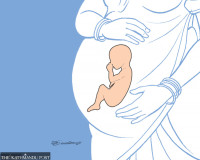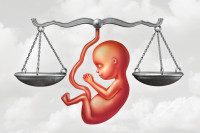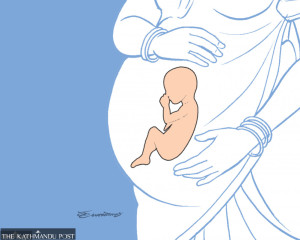Health
As virus cases surge, more children are testing positive for Covid-19
Children usually respond to regular medications, but rush them to hospital if symptoms, which resemble those of a typical viral infection, continue or fever does not come down, doctors say.
Arjun Poudel
Last week, two infants—one two months old and the other six months old who were taken to Om Hospital and Research Centre in Kathmandu, tested positive for Covid-19. Doctors had recommended a coronavirus test for those infants, as their mothers had tested positive.
“Both infants had mild symptoms of Covid-19–fever, runny nose, cough,” Dr Rita Hamal, a consultant paediatrician at the hospital, told the Post. “Conditions of those kids were not serious, but we should not forget that children too are getting infected in large numbers these days.”
When Nepal faced the first wave of the coronavirus last year, not many children were reported to have contracted the virus. A prolonged lockdown, school closure and other restrictive measures were considered the reasons why the infection rate was low among children.
However, the second wave of the pandemic is showing a different trend. While youths and adults, aged between 20 and 40 years, have been infected the most, the virus has been detected in those under 19 as well.
Experts say Nepal took things easily as the number of infections started to decline last year and everything started to open up, as though there was no pandemic.
“The start of in-person classes in schools is the main reason for children getting infected more this time,” said Hamal. “Since everything opened up and agencies did not pay attention to the enforcement of safety measures, just as people got too careless, infections are reaching those homes also where there are children.”
On Wednesday, 416 individuals under 20 tested positive for the virus. Of them, 99 were between the age of 0 and 9 and 317 were aged 9-19 years. The number has been on an increasing trend for the last few weeks. On Tuesday, 384 children under 20 were tested positive and on Monday the number was 336.
According to the Health Ministry, 3,227 children have tested positive for the coronavirus throughout the country over the last 16 days.
Ignoring warnings from doctors as well as public health experts, authorities concerned allowed schools to run in-person classes. Schools also were too adamant and continued running classes.
“First, my six-year-old son suffered from fever and cough. Then my daughter, who is three, got infected,” Laxmi Bhattarai, who lives in Manamaiju, Kathmandu told the Post. “Later my entire family including my father-in-law and mother-in-law got infected.”
Bhattarai, a homemaker, said her younger son and father-in-law have not shown any complications but she is worried.
She suspects that her elder child got infected at school and her daughter got infected from her brother. “Then everyone got infected at home,” she said.
The R, or reproduction, number of the virus in Nepal currently stands above 2, according to studies. The R number suggests how easily the virus can spread, as R is the number of people, on average, that one infected person will pass on a virus to.
Even though the numbers India is logging are staggering—362,902 infections and 3,285 deaths on Wednesday, the country’s R number is hovering around 1.5 or so.
Nepal on Wednesday reported 4,777 new infections. The Health Ministry said that 17 deaths were recorded in the last 24 hours. The death toll stands at 3,211.
Nepal’s total number of active cases currently stands at 30,209.
Doctors and public health experts have been saying that infections among children, youths and adults are a cause for concern. What is worrying is people can easily mistake Covid-19 symptoms with those of seasonal influenza and may avoid tests, thereby unknowingly helping the virus to spread even faster.
Availability also matters, according to Dr Sujit Shrestha, another paediatrician at Om Hospital.
“In the majority of cases, the problems may be sorted out by taking home remedies or some common drugs like paracetamol, but what should not be forgotten is that doctors should be consulted immediately if the condition starts to worsen or fever continues even 48 hours after taking paracetamol.”
According to experts, people must consult doctors if their children have some symptoms or if they test positive, and should not panic.
“Throughout the world, infections among children are fewer compared to adults and the elderly,” Shrestha told the Post. “Children rarely need intensive care and ventilator support due to infections. But if they have comorbidities—cancer, heart disease, renal problems and others—they may not only get serious but also die.”
Doctors say symptoms among children affected by Covid-19 resemble those of a typical viral infection, including headache, bodyache, vomiting, sore throat, red eyes, fever and sometimes diarrhoea. It can also be a high-grade fever, according to them.
Some children may suffer inflammation throughout the body sometimes several weeks after they are infected with the virus, which could be a sign of danger.
Children, however, are said to be responding to regular medications.
According to doctors, the symptoms may last two to three days on average. Even though they are less likely to develop complications like the adults on the seventh or 10th day of infection, attention must be paid and parents should be in close consultation with doctors, experts say.
“Even though the Health Ministry data show that a number of children are getting infected at an increasing rate of late, very few are being brought to hospital,” Dr Sumit Agrawal, a consultant pediatrician at Kanti Children’s Hospital, told the Post. “Of the total children being brought to the hospital, around 10 percent are testing positive for the coronavirus.”
Precautionary measures taken by parents with small children can prevent the virus from entering home. But it’s easier said than done, as the virus has already become widespread and penetrated communities.
Doctors say whenever children show symptoms, they must be tested and kept indoors.
“If symptoms continue and fever does not come down and children have difficulty breathing, they must be rushed to hospital almost immediately,” said Hamal, the paediatrician. “Bluish face and lips, having trouble in staying awake and chest pain are signs of serious complications.”




 14.99°C Kathmandu
14.99°C Kathmandu














